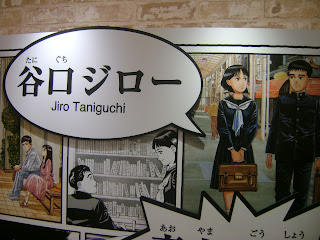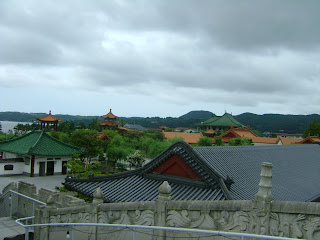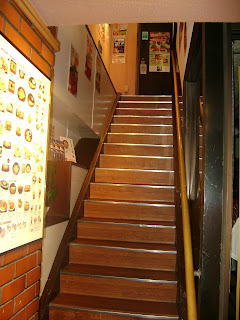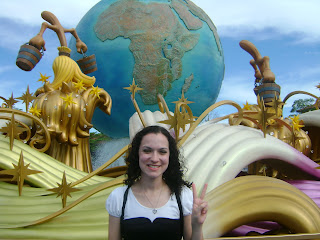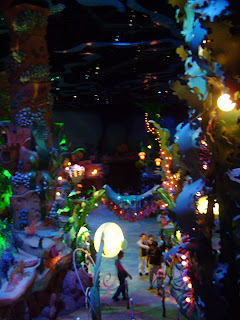This announcement surprised me, especially since it was 10 PM, I was about to set my alarm for my usual wake-up time of 9 AM, and I had no idea that I was supposed to receive a medical check-up. I'm all about staying healthy, so I simply replied, "OK! Thank you!"
My Japanese manager picked me up at my apartment, her face fixed in her omnipresent genuine smile. My other co-worker, who is from Canada, waited in the front seat. We made small talk as we rode along, passing restaurants and factories. After about five minutes, we arrived in front of the clinic. Our manager held a folder with what I assumed were medical or insurance documents for us (I was told that our company pays for our annual medical examination).
We walked inside and up the stairs to a waiting area. The walls were lined with windows, and since the weather was sunny and cool, the clinic felt calm and welcoming. The manager gave the receptionist our paperwork, and we sat down to wait for our turn. Maybe thirty seconds passed before my co-worker was summoned to go into the bathroom with a cup. I waited for about two minutes before I was called to do the same. The cup had "26" written on it. My manager explained that when I was done with my urine sample, I was to place my cup on the board by the receptionist's window. I glanced at the board, which reminded me of a game of numerical checkers. I saw the square for "26" and nodded.
After all three of us had completed that part of the examination, we walked down the hall to another room. Chairs lined the walls, and small sections separated by curtains hid medical assistants. When my name was called, I sat down across from a cheery woman who made every effort to speak to me in English.
"Relax!" she gently commanded. She touched the cushion on the table, and I placed my right arm on it. She took my blood pressure and then showed me what the results were.
"It's okay!" she exclaimed. She smiled at me and quickly bowed her head, signaling me to go back to the waiting area. I thanked her in Japanese and went back to my seat.
My co-worker was sitting in the next section, the curtain half-drawn. He was undergoing a vision test and a hearing test. I didn't understand what happened, but when he had finished, three medical assistants flocked around him and began discussing something. He glanced back at our manager, but then the ladies dispersed. I guess nothing serious had happened?
The woman then said my name, and I walked over. She stretched her arms apart vertically to show me that she was going to take my height, and then she stretched them horizontally to show me that she was going to weigh me as well. I removed my shoes and stepped on the footprints on the scale, which performed both tasks quickly and efficiently. She jotted down my measurements and my weight, and she then showed them to me and said, "OK!"
I think she meant that I was healthy and in a normal range for my size and frame.
She then motioned for me to sit down. She pointed to her eyes and asked me, "Contact lenses?" I nodded and said, "Hai, hai." She nodded back and pointed to the small screen before me.
I peered into the phoropter (yes, I looked up the name for this fancy optometry tool). I saw a circle with numbers 1 through 10 on the left, and then I saw 1 through 10 on three rows of varying sizes (from biggest at the top to smallest at the bottom). Beneath each number was a circle with a small piece of it missing. For example, underneath 1, the top part of the circle was missing; underneath 2, the right side of the circle was missing.
The woman then said something to me in Japanese, followed by "One." I didn't understand what she wanted me to do, so I looked up at her. She drew a circle in the air with her finger and then pointed up, down, left, and right. I nodded--a popular gesture for me--and looked back into the machine.
"One," she repeated. I noticed that the top part of the circle was missing, but I didn't know how to express my observation verbally. So, I did a little hand dance that may remind some of you of the "YMCA."
Translation: "The top is missing." ("Karate-chop!" is also acceptable.)
"The right side is missing." (Or maybe "Super-size me!")
"The bottom is missing." (Or "Yo, dawg, I dunno which 'hood I'm at.")
"The left side is missing." (Or "Please don't mistake this for some new American dance craze.")
After bearing with me, the sweet lady tested my left eye and right eye individually. My left eye is weaker than my right, even with contact lenses in, so whenever I answered--ahem, gestured--incorrectly, she made a polite "Hm" sound. She showed me that I had answered everything correctly for my right eye, but I had missed six for my left eye. I felt a wave of fear; would she make me order new corrective eye-wear? Would she summon ten doctors to inspect my eyes more closely?
Nope! She bowed, and my manager, co-worker, and I made our way for round-four in the clinic. We sat in the new waiting area. I tried to watch a Japanese soap opera that was playing on the TV. I think it was similar to ER, which I have never actually viewed.
"Roberts Celeste-san?"
Time for a new dance so soon?
I walked into the new room, which was sectioned by curtains again. The doctor motioned for me to sit down on the stool, and she sat down across from me. She took out her stethoscope, and she made motions for me to lift up my shirt. I did so, and she proceeded to check my heartbeat. Nothing unusual there.
Afterwards, I went back into the waiting area, but I sat for no longer than one minute: time for my X-ray.
The X-ray tech bowed to me and showed me into a small room with plenty of space, minus the X-ray machine. He fumbled for English words and made gestures on his chest, as though he were removing something.
"Oh, bra?" I asked.
"Hai, hai. Please remove."
He stepped out of the room to allow me privacy. I left on my cami, but when he returned, he politely pointed to it and shook his hands. He handed me an over-sized orange t-shirt and stepped out again. I changed and walked to the window to see whether he was ready.
He walked in again and led me to the X-ray machine.
"Chin," he instructed, and he patted the indention. I placed my chin on it, and he then placed my arms on the sides of the machine.
"Please relax."
The whole process took maybe fifteen seconds, and he bowed to me and then motioned to my clothes before leaving the room again. I dressed myself and then reached for the door, but he was faster than I was. He walked me out to the waiting area again and thanked me in both Japanese and English.
Our whole appointment lasted for about 45 minutes. I imagine we may have left sooner had we not had to deal with my confusion, but overall, I cannot get over how efficient this "assembly line" method is (as my co-worker coined it).
Have you ever had to receive medical care in Japan or in another country? What was your experience like? Share with me, please!
Till next time--see you!




